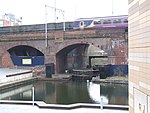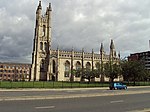Limelight Health and Well-being Hub
Buildings and structures in TraffordClinics in the United KingdomOrganisations based in Trafford
Limelight is a community health centre in Old Trafford run by Trafford Housing Trust designed to improve the health outcomes of local people. It contains 81 extra care apartments two GP surgeries, a public library, a community café, an optician, a pharmacy, a hair and beauty salon, and a 40-place children's nursery. There are event spaces that can be hired for weddings or business meetings. St Brides Church and rectory has also relocated to the site.
Excerpt from the Wikipedia article Limelight Health and Well-being Hub (License: CC BY-SA 3.0, Authors).Limelight Health and Well-being Hub
St. Brides Way, Trafford Old Trafford
Geographical coordinates (GPS) Address Nearby Places Show on map
Geographical coordinates (GPS)
| Latitude | Longitude |
|---|---|
| N 53.461 ° | E -2.262 ° |
Address
St Bride's Church
St. Brides Way
M16 9NW Trafford, Old Trafford
England, United Kingdom
Open on Google Maps








